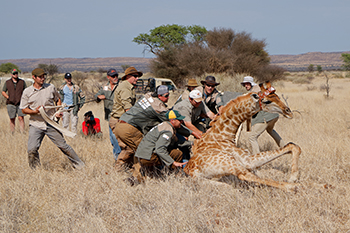
Dr Deacon from the Department of Animal, Wildlife and Grassland
Sciences at the University of the Free State (UFS),
lead a multispecialist research group to catch
and collar giraffe to collect data that will
contribute to the conservation of these animals.
Photo: Prof Nico Smith
Capturing 51 giraffes without any injuries or mortalities to collect data that will contribute to the conservation of these animals is not for everyone. Capturing a giraffe with minimum risk to the animal and the people involved, requires extraordinary skill, planning, and teamwork. “This exercise is a dangerous task, since a well-placed kick from these large and extremely powerful animals can cause serious injuries. Early in October was the first time that giraffes were captured on such a large scale,” said wildlife researcher Dr Francois Deacon.
Dr Deacon from the Department of Animal, Wildlife and Grassland Sciences at the University of the Free State (UFS), led a multispecialist research group of over 30 people from 10 different countries to collect information about these little-known animals.
UFS first to collar giraffe
Taking a global approach, the team responsible for this intricate process consisted of wildlife biologists, conservationists, interdisciplinary scientists and five specialist veterinarians who are experienced in catching and working with wild animals. Specialised drugs sponsored by Dr Kobus Raath from Wildlife Pharmaceuticals, tested for the first time and administered with a dart gun were used to tranquillise the giraffe, which then allowed for the GPS collars to be fitted. These collars, sponsored by Africa Wildlife Tracking, enable the researchers to record the location of individual giraffe for up to two years, give 24/7 readings, irrespective of weather conditions. In this cost-effective manner, data can be gathered on climatic factors, giraffe communication, social behaviour, home ranges, seasonal movements, human and giraffe interaction zones, as well as migration routes and the duration of the migration process. The collars will effectively be used to locate individuals to collect faecal samples for hormonal cycles, stress hormones, nutrient deficiencies based on diet and also internal parasites.
“This knowledge we gain is the key to all keys in saving this iconic animal from becoming extinct,” said Dr Deacon.
Six years ago, during a pilot study, Dr Deacon was the first researcher to fit giraffes with a GPS collar. Collaring is less invasive and allows researchers to collect detailed samples. Not only was extensive knowledge and experience gained during the process, but he also initiated interest from the filmmaker and conservationist, Ashley Scott Davison, executive producer of Iniosante Inc.
Getting to tell the story
Davison, who was doing research for a film on giraffe learnt about the silent extinction of the species. In a great number of countries giraffe numbers have been declining by as much as 40% over only a few years since 2000. Today West Africa has between 400 to 600 giraffe left while four out of five giraffes were lost in East Africa since 2000. This is a considerable decline in numbers and poses a real threat to the survival of the species in the longer term. At the end of 2016, the giraffe was classified as vulnerable on the International Union for Conservation of Nature Red Data list.
According to Davison, children in school learn about the destruction caused by ivory poaching and habitat loss. But in Africa today, there are six times as many elephants as there are giraffes.
In the process to find out more about this majestic species Davison learnt of Dr Deacon’s work. After being introduced to and spending time with Dr Deacon, Davison not only describes the UFS as the leader in the conservation of giraffes but he returned to the university, three times to help build a dedicated research team to address unanswered research questions within various disciplines.
Flowing from the affiliation with the UFS is Iniosante’s award-winning production of a documentary, “Last of the Longnecks”. The film has received several awards, including official selection at the 2017 Global Peace Film Festival, the Wildlife Conservation Film Festival and the Environmental Film Festival in the US capital.
The film team accompanied the multispecialist research team last week to gather footage for a follow-up documentary, “Catching Giants”. This film is expected to air in middle 2018.
Video clip of the event: https://www.dropbox.com/s/d3kv9we690bwwto/giraffe_UFS_revision-01a.mp4?dl=0
Video clip of the event: RooistoelTV
Former articles on this topic:
18 Nov 2016: http://www.ufs.ac.za/templates/news-archive-item?news=7964
23 August 2016: http://www.ufs.ac.za/templates/news-archive-item?news=7856
9 March 2016:Giraffe research broadcast on National Geographic channel
18 Sept 2015 Researchers reach out across continents in giraffe research
29 May 2015: Researchers international leaders in satellite tracking in the wildlife environment